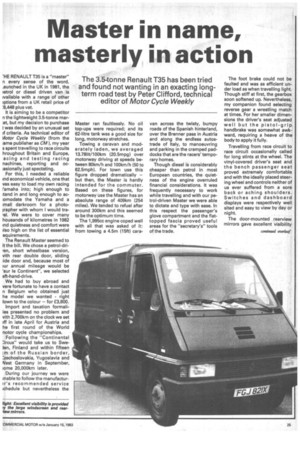Master in name, masterly in action
Page 27

If you've noticed an error in this article please click here to report it so we can fix it.
The 3.5-tonne Renault T35 has been tried and found not wanting in an exacting longterm road test by Peter Clifford, technical editor of Motor Cycle Weekly
HE RENAULT T35 is a "master" n every sense of the word. .aunched in the UK in 1981, the )etrol or diesel driven van is ivailable with a range of other )ptions from a UK retail price of :6,448 plus vat.
It is aiming to be a competitor n the lightweight 3.5-tonne mar:et, but my decision to purchase t was decided by an unusual set 4 criteria. As technical editor of Itiotor Cycle Weekly (from the ,ame publisher as CM), my year s spent travelling to race circuits hroughout Britain and Europe, acing and testing racing nachines, reporting and oc:asionally just spectating.
For this, I needed a reliable Ind economical vehicle, one that vas easy to load my own racing ramaha into; high enough to land in and long enough to ac:omodate the Yamaha and a mall darkroom for a photorapher with whom I would traFel. We were to cover many housands of kilometres in 1982 Ind quietness and comfort were ilso high on the list of essential equirements.
The Renault Master seemed to it the bill. We chose a petrol-driPen, short wheelbase version, vith rear double door, sliding .ide door and, because most of air annual mileage would be 'sur le Continent", we selected aft-hand-drive.
We had to buy abroad and vere fortunate to have a contact n Belgium who obtained just he model we wanted right lown to the colour — for £3,800. Import and taxation formaliies presented no problem and vith 2,700km on the clock we set )fif in late April for Austria and he first round of the World notor cycle championships. Following the "Continental :ircus" would take us to Swelen, Finland and within fifteen ;ift of the Russian border, :zechoslovakia, Yugoslavia and Nest Germany in September, iome 20,000km later.
During our journey we were inable to follow the manufactur:Cs recommended service :chedule but nevertheless the Master ran faultlessly. No oil top-ups were required; and its 62-litre tank was a good size for long, motorway stretches.
Towing a caravan and moderately laden, we averaged 13.781it/100km (20.5mpg) over motorway driving at speeds between 80km/h and 100km/h (50 to 62.5mph). For town use this figure dropped dramatically — but then, the Master is hardly intended for the commuter. Based on these figures, for motorway use the Master has an absolute range of 409km (254 miles). We tended to refuel after around 300km and this seemed to be the optimum time.
The 1,995cc engine coped well with all that was asked of it: from towing a 4.5m (15ft) cara
van across the twisty, bumpy roads of the Spanish hinterland, over the Brenner pass in Austria and along the endless autostrade of Italy, to manoeuvring and parking in the cramped paddocks that are the racers' ternporary homes.
Though diesel is considerably cheaper than petrol in most European countries, the quietness of the engine overruled financial considerations. It was frequently necessary to work while travelling and with our petrol-driven Master we were able to dictate and type with ease. In this respect the passenger's glove compartment and the flattopped fascia proved useful areas for the "secretary's" tools of the trade.








































































































